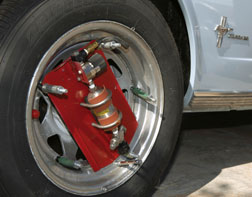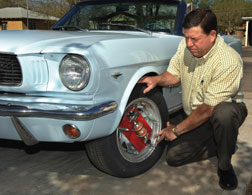NEWS RELEASES
FOR IMMEDIATE RELEASE
May 18, 2005
Sandia helps small company with automatic tire pressure maintenance system
 Detail of automatic tire pressure system, developed
by Dale Petty of Petty Farm and Ranch in Clovis, N.M., with
help from Sandia. (Photo by Randy Montoya)
Detail of automatic tire pressure system, developed
by Dale Petty of Petty Farm and Ranch in Clovis, N.M., with
help from Sandia. (Photo by Randy Montoya)Download 300dpi JPEG image, “tire-pressure-detail.jpg,” 892K (Media are welcome to download/publish this image with related news stories.)
ALBUQUERQUE, N.M. — The National Nuclear Security Administration’s Sandia National Laboratories recently provided three engineering concepts to small business owner Dale Petty for a gadget that keeps car tires inflated to the right pressure.
Now Petty wants to turn one of the concepts into a life-saving product, and he is marketing the idea to various companies.
Petty, owner of Petty Farm and Ranch in Clovis, N.M., was tired of maintaining his old farm tires and dealing with blowouts caused by low tire pressure. He wanted to develop a device that would automatically check tires for the recommended pressure and add or release air.
He sought assistance from Sandia’s Small Business Assistance Program and was partnered with Sandia researcher John Browning.
Browning came up with various ideas for maintaining the manufacturer’s recommended tire pressure without having to do it manually. He suggested three engineering concepts to Petty: an air compressor system, a high-pressure bottle, and a gas generator.
Prototype versions of two of the design concepts have been created and tested.
 Dale Petty demonstrates the automatic tire pressure maintenance system using wheel-mounted high-pressure nitrogen bottles. (Photo by Randy Montoya)
Dale Petty demonstrates the automatic tire pressure maintenance system using wheel-mounted high-pressure nitrogen bottles. (Photo by Randy Montoya)Download 300dpi JPEG image, “tire-pressure-system.jpg,” 1.1MB (Media are welcome to download/publish this image with related news stories.)
Three concepts
The air compressor concept is similar to systems that operate tools powered by compressed air. A centrally located air compressor would call for tire inflation pressure to come through the air channel of a rotary union mounted on the wheel. John says this concept would work well in semi tractor trailers, for example, but could not be easily implemented on the majority of passenger vehicles that use constant-velocity joints. A more expensive system could put an air compressor on each wheel, and would require power to be provided through a slip connection on the axles.
The high-pressure bottle concept is similar to systems used to inflate life rafts and aircraft emergency slides. A high-pressure bottle with a pressure regulator can be placed on each wheel of almost any vehicle. Product pricing issues, however, include costs of the high-pressure-rated parts and possible regulatory maintenance requirements such as periodic testing of the system components.
The gas generator concept would use materials already in use in automobiles today to inflate airbags. A series of small, hot-wire-ignited pellets (e.g., sodium azide) could provide nitrogen gas for periodically replacing lost tire pressure. The pellets could be mounted on a flex circuit board, which would be strapped around the tire rim inside the tire volume, along with a battery, pressure sensor, microcontroller, and igniter electronics. John says the gas generator concept is potentially the lowest cost manufacturing solution, but because of the relatively high development cost was not pursued under the small business assistance project.
Air compressor
The air compressor concept was chosen in the preliminary
design of an automatic tire pressure maintenance system.
A prototype system was built under the small business assistance
project to address the safety and economic issues of under-inflated
automobile tires frequently driven on American's roadways.
A portable prototype has been created to hand-carry to trade shows and potential customers. The portable system is designed for demonstrations, and may be powered either by a portable 12-volt, sealed lead-acid battery (with a 110-volt AC battery charger), or by a 12-volt DC output, 110-volt AC power converter. The system features a mounted tire and wheel, attached to a pedestal by a bearing, with a handle for manually rotating the tire. A carrying case is included. The pedestal contains an air compressor, pressure switch, and vent valve, with associated tubing and wired connections to a control box with an internal pressure sensor.
The prototype has some features similar to the Dana Corporation's central tire inflation systems (CTIS) which have found utility in the trucking industry, particularly in off-road vehicles, and have been employed with both trailer axle vehicles and tractor drive axle vehicles. The CTIS is currently available on some models of the Hummer, but, says Petty, ìHopefully someday all vehicles will be equipped with a device that will help save lives.î
High pressure bottle
With the assistance of Dale Petty's brother David, an automotive
technician at Galles Chevrolet in Albuquerque, an automatic
tire pressure maintenance system using wheel-mounted high-pressure
nitrogen bottles was created as well.
The system has been installed on all four wheels of a 1966 Ford Mustang.
Testing of the system included tire balance check and various bottle road tests. The bottle road tests rim and tire assemblies, shock and vibration from various highway speeds, and the structural integrity of the system. In addition, tests were conducted to detect leaks and simulation of proper functioning of the automatic tire pressure maintenance system.
Small idea, big concept
Petty says the idea for the system came after his son came
home with a homework assignment. The assignment was to not
to reinvent the wheel but to make it better. Petty sat on
the idea for a year and soon contacted Sandia's Small Business
Assistance Center.
Besides being tired of changing flats and dealing with blowouts, Petty says the idea was also based on safety. He was alarmed with the 2000 recall of Bridgestone/Firestone's 6.5 million tires.
“I am pleased with all the assistance Sandia provided,” Petty says. “Sandia took the lead and helped out tremendously.”
Link:
Sandia helps 278 state businesses in 2004 through New Mexico
Small Business Assistance Program
Sandia is a multiprogram laboratory operated by Sandia Corporation, a Lockheed Martin company, for the U.S. Department of Energy’s National Nuclear Security Administration. Sandia has major R&D responsibilities in national security, energy and environmental technologies, and economic competitiveness.
Sandia media contact: Michael Padilla, mjpadil@sandia.gov, (505) 284-5325